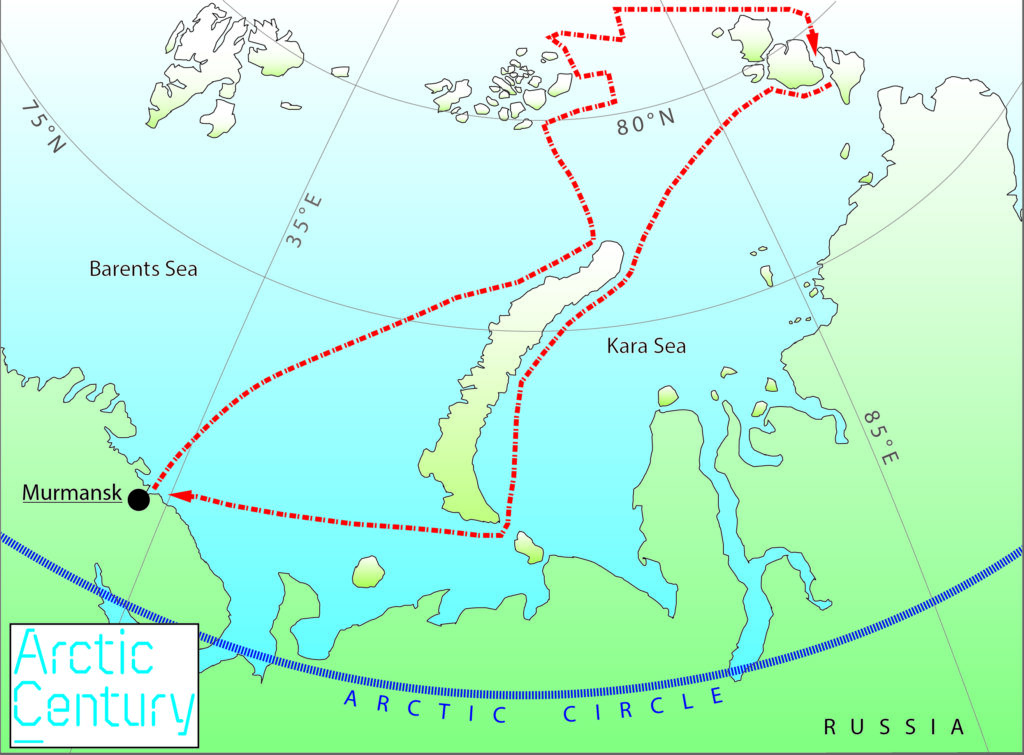Arctic Century – a multidisciplinary scientific expedition to the Laptev and Kara Seas
The Arctic is warming faster than almost any other territory on Earth. As a result, the region is changing rapidly: glaciers are melting, sea ice is disappearing and permafrost is thawing, which, in turn, will further accelerate climate change. The marine and terrestrial ecosystems here are changing faster than expected, and plant and animal species adapted to harsh conditions at the margins of life are threatened. Moreover, new challenges to the marine and terrestrial environment and the Arctic coastal communities are emerging, for instance, the opening of new navigation routes and economic development. Last but not least, these changes affect the livelihoods of four million people.
The Arctic Century Expedition is combining multiple scientific disciplines to study remote and rarely accessible areas in the Kara and Laptev Seas in the western Arctic.
The scientific programme focuses on diverse and important aspects of the atmosphere, cryosphere, marine and terrestrial environment in a rapidly changing Arctic. Interdisciplinary studies are carried out by an international team of researchers addressing the following topics:
- Marine, coastal and terrestrial ecology: exploring the race for cooler temperatures towards the poles by marine fish and mammals with environmental DNA; macro- and microplastics in Arctic waters; late-summer distribution and abundance of seabirds and marine mammals; unexplored biodiversity of soil microbes and vegetation at the margin of life on Arctic islands.
- Ocean sciences: Atlantic water masses in the western Arctic: modern distribution and variability since the last glacial maximum.
- Biogeochemical cycles in the Eurasian Arctic: the fate of terrestrial organic matter in the marine environment; biogeochemical processes and climate-induced shifts in the Kara and Laptev Seas; dynamics of nutrients and dissolved gases.
- Recent climate variability and glacier dynamics: high Arctic stable water isotopes of ice caps and terrestrial permafrost; sediment discharge from glaciers to the sea floor; sea level history of the high Arctic islands during the Holocene.
The main working region of the Arctic Century Expedition comprises the Barents, Kara and northwestern Laptev Seas and the archipelagos of Franz Josef Land and Severnaya Zemlya (Fig. 1).

This expedition is unique through its multidisciplinary approach addressing the physics, geochemistry and ecology of the atmosphere, glaciers, ocean and land in the high Arctic, documenting the status but also investigating the past.
The expedition is organised jointly by the Swiss Polar Institute, the Arctic and Antarctic Research Institute in Russia and the GEOMAR Helmholtz Centre for Ocean Research Kiel in Germany. 59 scientists from the following universities and research institutes are participating:
- Alfred Wegener Institute Helmholtz Centre for Polar and Marine Research, Germany (AWI)
- A.N. Severtsov Institute of Ecology and Evolution of the Russian Academy of Sciences, Moscow, Russia (IEE RAS)
- Arctic and Antarctic Research Institute, St. Petersburg, Russia (AARI)
- Finnish Meteorological Institute, Helsinki, Finland (FMI)
- GEOMAR Helmholtz Centre for Ocean Research Kiel, Germany (GEOMAR)
- Institute of Marine Sciences, Barcelona, Spain (ICM)
- Lomonosov Moscow State University, Russia (MSU)
- Swiss Federal Research Institute WSL, Birmensdorf, Switzerland (WSL)
- Swiss Federal Institute of Technology Lausanne, Switzerland (EPFL)
- Swiss Federal Institute of Technology Zurich, Switzerland (ETHZ)
- University of Bergen, Norway (UiB)
- University of Cape Town, South Africa (UCT)
- University of Lausanne, Switzerland (UNIL)
- University of Zurich, Switzerland (UZH)
